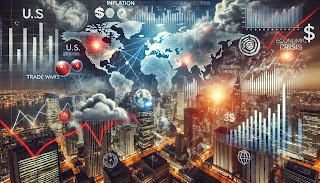Global Economic Risks in 2025 – Are We on the Brink of a New Crisis?
The global economy in 2025 faces accumulated risks and potential new crises. Factors such as U.S. protectionism, geopolitical instability, China’s economic slowdown, and persistent inflation are shaking the world economy. In this article, we will analyze the key risks threatening the global economy in 2025 and explore possible strategies for governments and businesses.
📌 1. U.S. Protectionism – The Start of a New Trade War?
🔹 Changes in U.S. Tariff Policies
With the possible return of the Trump administration or a new leadership in the White House, there is a high probability that protectionist policies will be reinforced. Trump has previously proposed a 10–20% tariff on all imports and up to 60% tariffs on Chinese products.
🔺 Key Impacts:
- Slower global trade → Decline in world GDP growth 📉
- Direct impact on China, Europe, and emerging economies
- Reduced export competitiveness for manufacturing economies (South Korea, Germany, Japan)
📌 Business & National Strategies
✅ Diversify supply chains: Reduce dependence on the U.S. and China by expanding into India, Southeast Asia, etc.
✅ Utilize FTAs: Leverage free trade agreements to mitigate the impact of protectionism
✅ Innovate business models: Expand domestic production facilities and implement cost-cutting measures
📌 2. Geopolitical Instability – A Major Economic Disruptor
🔹 Ongoing Conflicts in Ukraine and the Middle East
Geopolitical risks continue to shock the global economy.
- Ongoing Ukraine war: Increased volatility in energy and food prices
- Middle East tensions: Conflicts between Israel and Palestine, Iran’s nuclear issue, and oil supply concerns
📉 Economic Impact:
- Rising oil and gas prices → Higher global inflation
- Increased investment uncertainty → Decline in foreign direct investment
- Supply chain disruptions → Increased production costs for businesses
📌 Business & National Strategies
✅ Diversify energy sources: Expand renewable energy investments and secure alternative oil suppliers (U.S., Australia)
✅ Prepare for geopolitical risks: Implement hedging strategies to manage financial market volatility
✅ Establish contingency plans: Restructure supply chains and secure raw materials
📌 3. China’s Economic Slowdown – A Growing Burden on the World Economy
🔹 Declining Growth Rate in China
China’s growth rate is projected to slow to 4.1% in 2025 due to a real estate market downturn, weak consumer spending, and rising local government debt.
📉 Economic Impact:
- Reduced Chinese consumption → Negative impact on exports from South Korea, Japan, and Europe
- Slowing global manufacturing → Decreased demand for raw materials
- Continued depreciation of the yuan → Increased financial market instability
📌 Business & National Strategies
✅ Expand into emerging markets: Reduce dependence on China and focus on India, Southeast Asia, and the Middle East
✅ Invest in high-value industries: Diversify portfolios into advanced technology, biotech, and green industries
✅ Manage financial risks: Implement forex policies to mitigate yuan volatility
📌 4. Inflation and Central Bank Policy Changes
🔹 Persistent Inflation
- Interest rate changes in the U.S. and Europe will be a key determinant of economic trends
- The Federal Reserve and the European Central Bank (ECB) may cut rates, but uncertainty remains
📉 Economic Impact:
- If rates are cut → Asset markets rebound, increased consumer spending & investment
- If rates remain high → Continued recession fears and rising debt burdens
📌 Business & National Strategies
✅ Prepare for interest rate fluctuations: Adjust bond, real estate, and portfolio allocations
✅ Enhance price competitiveness: Develop cost-saving strategies for high-inflation periods
✅ Analyze consumer behavior: Adapt marketing strategies to shifting purchasing patterns
📌 5. 2025 Global Economic Outlook and Response Strategies
2025 is expected to be a highly uncertain year. The combination of protectionism, geopolitical crises, China’s economic slowdown, and persistent inflation presents significant challenges to the world economy.
📌 Key Takeaways for Businesses & Investors
✅ Diversification is essential: Reduce reliance on specific countries/markets and expand into emerging economies
✅ Supply chain risk management: Prepare for ongoing U.S.-China trade disputes
✅ Liquidity management: Develop financial strategies to navigate interest rate fluctuations and inflation risks

Comments
Post a Comment